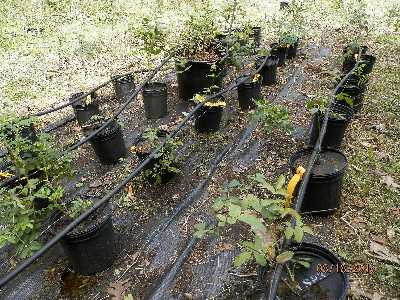

Roseraie page that I edit frequently showing roses in the field, maybe for sale.
Most of the spring, summer and fall we grow several thousand roses and lilacs in pots on drip line in the fields of our flowering shrub farm showing pictures in the newsletter. When plants flower (lilacs in May and roses in June or July) I relabel them, add a price sticker, and overwrite old with new cuttings pictures. In July, August and September I take cuttings to root under mist in my coldframes.
Pictures like these three above are at the top of each individual variety page; from left to right 1) the flower picture, 2) the cuttings picture (when a price sticker is visible it may be for sale) and 3) the plant in June and sometimes 4) fall foliage or fruit. Check out help showing other pictures we sometimes take as the cuttings picture.
Click this blue variety name link similar to those that appear in a catalog. 36) 'MAGNIFICA'_Hybrid Rugosa Rose
We plant several of each variety in prepared soil along drip lines in the nursery like these two above Albertine on the left planted in 2016 (click picture for a larger image and check date the picture was taken in the lower right hand corner) and Rosa damascena Ispahan on the right that was planted maybe 10 years ago (some additional roses planted along drip line are shown at the bottom of this page). It may take several years after they have been planted before they are large enough for us to start taking cuttings from them.
When plants are large enough hundreds of cuttings are taken and stuck in one of our outdoor misting facilities either mist using an electronic leaf like on the left or mist interval using a timer as on the right.
Cuttings that have rooted are potted up and grown on drip line until they flower, are identified, labeled, had a price sticker attached, similar plants grouped together and a cuttings picture taken that will appear in the newsletter and elsewhere.
In Spring we take roses from the cold box where they have been protected during the winter from mice and rabbits and line them up on drip line where they will get lots of sunlight, they can be fertilized easily with a handful of Espoma Rose Tone each month and they will get watered. The drip lines can water each potted plant with a half gallon of water per hour (I walk along looking for those not properly aligned with the drip emitter, kicking the pot into a better position so the water drips into the pot).
being packaged for mail order
I can send plants to the following states without having to have them inspected; Connecticut, Delaware, District of Columbia, Florida, Georgia, Illinois, Indiana, Kentucky, Maine, Maryland, Massachusetts, Michigan, New Hampshire, New Jersey, New York, North Carolina, Ohio, Pennsylvania, Rhode Island, South Carolina, Vermont, Virginia, West Virginia, Wisconsin, Wyoming (I cut the address out of your email printout and stick it to the package).
In June and July as they flower I verify the identity of each variety, relabel them if necessary and attach a price sticker.
In July, August and September I take cuttings and place them under mist (either mist using an electronic leaf like on the left or mist interval using a timer as on the right). The mist keeps the air around plants or cuttings moist, the leaf surfaces cool and yet doesn't affect the temperature of the soil that has to remain between 60 and 70 degrees for cuttings to root.
schneekopp, schneezwerg
Above are pictures of the Hybrid Rugosa Roses 'Schneekopp' and 'Schneezwerg' planted in ground somewhere along a dripline. Roses that will grow really large get planted at the end of the drip line, smaller ones get planted every 12 feet along side the drip line (below left is '4 seasons' Autumn Damask in ground along side the drip line).
Four Seasons Autumn Damask Rose planted next to the drip line at a 12 foot interval (4 Four seasons roses that will grow to around three feet tall are planted every 12 feet along here).
january dripline where roses have been stored in cold box for the winter.
pot in pot
Roses hardy to zone 3 planted in 7 gallon pots that we will use as a source of cuttings in summer placed on drip line and in winter placed pot in pot their roots surrounded by mulch. Rooted cuttings are sometimes grown this way until they are larger.
coldframe
Cold box 1 along side of the cold frame is used as a table in summer, then the tops are opened and the plants are placed inside for the winter.
cold box 1 in coldframe getting covered and with the lid open so we can examine them.
Roses closed in cold box 2 in the upper field, their yellow labels showing an abreviation of what we think they may be or a number. I can go looking for a variety in the box, then take a picture so the label can be read.
Each 4 foot by 4 foot cell in cold box 2
last of the 4 by 4 cells, cuttings ispahan
la belle sultane, stanwell perpetual
We grow large roses like these in raised beds or 45 gallon pots that we can take cuttings from.
fantin latour, pauls himalayan musk
ispahan, rose hedge with Pauls Himalayan Musk, William Baffin and Complicata.
city of york, alchymist
Four Seasons autumn damask, Dortmund Climber
ispahan, leverkusen
new dawn, goldfinch
trier
cuttings roseraie de l'hay, cuttings henry hudson
HOME PLANT SALE ROSES ROSERAIE ALBA GALLICA DAMASK CENTIFOLIA RUGOSA CLIMBING OLDROSE ZONE3ROSE NEWSLETTER GROWING LILACS LILACGRO DIVIDE BAREROOT INSTOCK LIST HELP ORDERING CONTACT